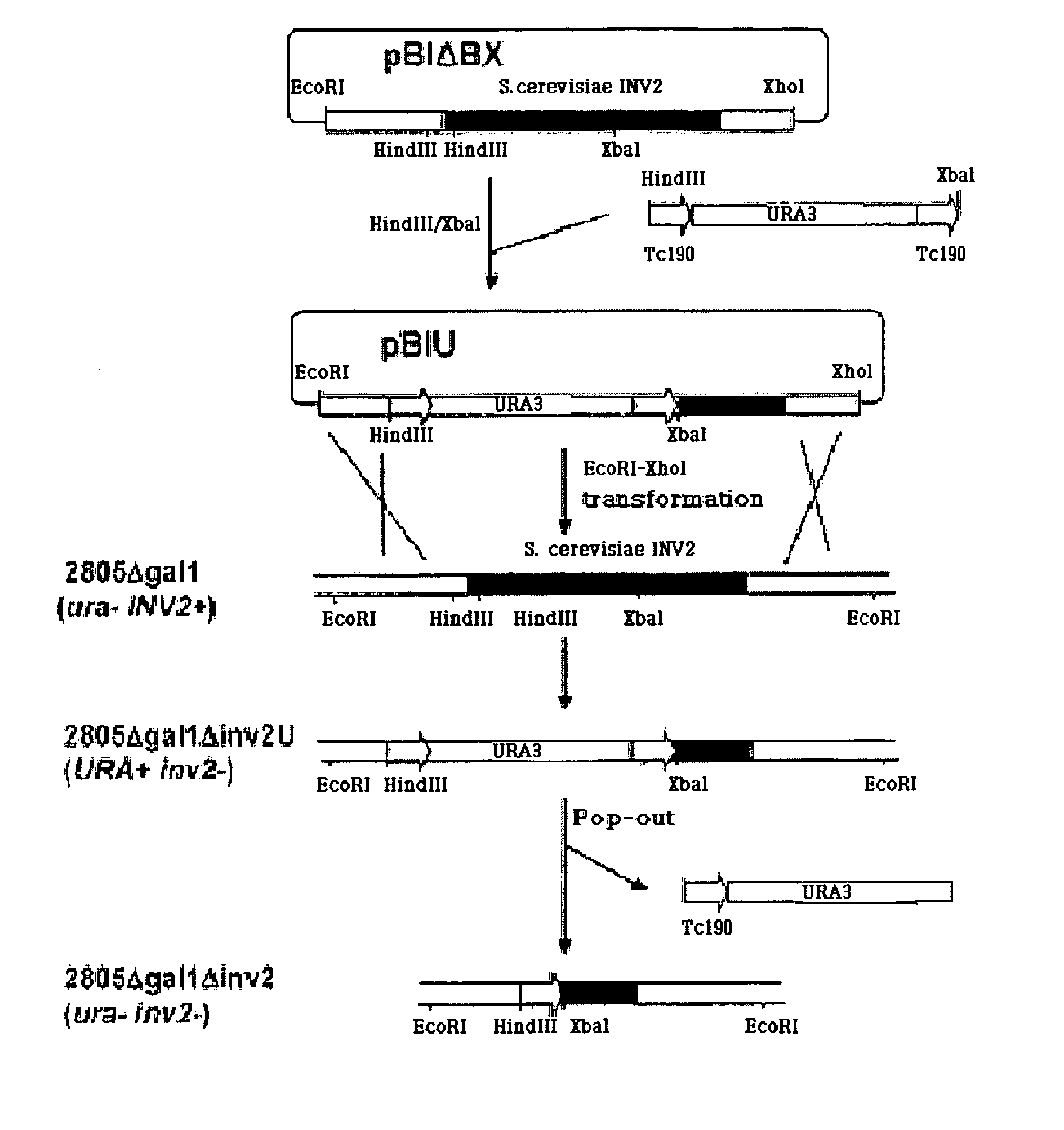Rapid Screening Method of Translational Fusion Partners for Producing Recombinant Proteins and Translational Fusion Partners Screened Therefrom
a technology of translational fusion and recombinant proteins, which is applied in the direction of polypeptides with enzyme fusion, organic chemistry, peptides, etc., can solve the problems of not being able to apply to all proteins, and achieve low cost, low expression levels, and inability to produce at large scale
- Summary
- Abstract
- Description
- Claims
- Application Information
AI Technical Summary
Benefits of technology
Problems solved by technology
Method used
Image
Examples
example 1
Preparation of Invertase-Deficient Yeast Mutant
[0085] For rapid screening of translational fusion partners of non-producible proteins, an automatic screening system was established through the evaluation of cell growth in a sucrose medium using yeast invertase as a reporter.
[0086] A yeast strain deficient for invertase activity was required to use the invertase gene contained in a vector as a reporter gene upon screening after transformation. Thus, the INV2 gene was deleted in yeast chromosomal DNA. In order to prepare a cassette for inducing gene deletion, a pRB58 plasmid (Carlson et al., Cell, 1982, 20, 145) was digested with EcoRI and XhoI, and an INV2 coding gene was recovered and introduced into EcoRI / XhoI sites of pBluescript KS+ (Stratagene, USA), thus generating pBIABX. As shown in FIG. 1, an URA3 gene having a repeat sequence of 190 bp (Tc190) at both its ends was inserted into HindIII-XbaI sites of the INV2 gene contained in the pBIABX, thus generating pBIU. The pBIU was...
example 2
Identification of Automatic Screening System Through Fusion with Invertase
[0089] The invertase gene-deficient strain was evaluated for the possibility of being automatically screened in a sucrose medium through the expression of a protein fused to invertase, using a human protein expressed in high levels in yeast, human serum albumin (HSA), and a non-producible protein, human interleukin-2 (IL-2).
[0090] First, a pGHSA-INV2 vector in which albumin is fused to invertase was prepared as follows. In order to insert a SfiI recognition sequence into both ends of the HSA gene, PCR was carried out using a sense primer and an anti-sense primer, each of which has a SfiI recognition sequence, JH97 (Sfi-HSA-forward primer) (SEQ ID NO. 11) and JH119 (Sfi-HSA-reverse primer) (SEQ ID NO. 12), respectively, pYHSA5 (Kang et al., J. Microbiol. Biotechnol., 1998, 8, 42) as a template, and Pfu polymerase (Stratagene, USA). PCR conditions included one cycle of 94° C. for 5 min, and 25 cycles of 94° C....
example 3
Preparation of Translational Fusion Partner Screening Vector using a Non-Producible Protein Human IL-2
[0093] In order to obtain suitable translational fusion partners capable of inducing secretion of a fusion protein using the pGIL2-INV2 vector in which IL-2 is fused to invertase, vectors having three reading frames for preparing a library, pYHTS-F0, F1 and F2, were prepared (FIG. 6).
[0094] PCR was carried out using sense primers having three reading frames and a BamHI recognition site, JH120 (BamHI-IL2-1-forward primer) (SEQ ID NO. 17), JH121 (BamHI-IL2-2-forward primer) (SEQ ID NO. 18) and JH122 (BamHI-IL2-3-forward primer) (SEQ ID NO. 19), an antisense primer, JH123 (INV-1-reverse primer) (SEQ ID NO. 20), pGIL2-INV2 as a template, and Pfu polymerase (Stratagene, USA). PCR conditions included one cycle of 94° C. for 3 min, and 25 cycles of 94° C. for 30 sec, 55° C. for 30 sec and 72° C. for 1 min, followed by one final cycle of 72° C. for 7 min. PCR products of about 1.2 kb, con...
PUM
| Property | Measurement | Unit |
|---|---|---|
| temperature | aaaaa | aaaaa |
| temperature | aaaaa | aaaaa |
| temperature | aaaaa | aaaaa |
Abstract
Description
Claims
Application Information
 Login to View More
Login to View More - R&D
- Intellectual Property
- Life Sciences
- Materials
- Tech Scout
- Unparalleled Data Quality
- Higher Quality Content
- 60% Fewer Hallucinations
Browse by: Latest US Patents, China's latest patents, Technical Efficacy Thesaurus, Application Domain, Technology Topic, Popular Technical Reports.
© 2025 PatSnap. All rights reserved.Legal|Privacy policy|Modern Slavery Act Transparency Statement|Sitemap|About US| Contact US: help@patsnap.com



